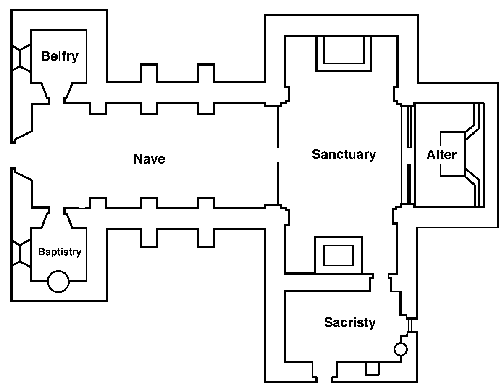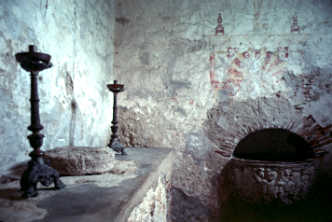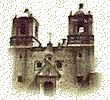|
|
The Sacristy of
Mission Concepción Sister Mission to Valero |
Such was the way Sunday mass would typically begin at Mission Concepción in the 1700's. Structurally, Mission Concepción church has changed little since then. The original bell towers and choir loft remain intact, while the lyrical voices has never collapsed. Even the small room from which the friar would make his grand entrance looks very much the same. The vaulted ceiling, the walls, window, wash basin, wall painting, and side board in the room all date back to the mission period. At that time, the room served as the sacristy, a chamber in which preparations were made for the daily religious celebrations.
Traditionally located next to the sanctuary or altar area, a sacristy is a room used to store the ritual clothing (vestments) and sacred vessels. Today, the Mission Concepción sacristy no longer harbors any Spanish colonial vestments, vessels, or furnishings. Even its original flooring and doors were lost during the 1800's when the mission was abandoned and the church used as a stable. However, for all that is lost, the Testimony and Inventory of Mission Concepción (1772) has left us a detailed description. With the aid of the Inventory and the Instructions for the Mission Concepción (ca. 1760), we can imagine just how a friar would have prepared for a mass in the Mission Concepción sacristy in the year 1772:

The lone sacristy window never provided enough light, so the friar always prepared by candlelight. The flame cast flickering shadows upon the arm chair, a large earthen water jar, the gilded set of drawers and closets, and a three foot high canvas painting of Jesus. The vestments were kept in the drawers along the west wall. The friar stood upon a woolen rug and donned his ceremonial robes while reciting the traditional vesting prayers. Occasionally he gazed up at the wall painting above the drawers as if to draw inspiration for the morning's mass.
The friar first put on the alb, a long sleeved, white linen garment. Next followed the chasuble, an ornate, sleeveless outer vestment. The drawers contained chasubles of many colors, some lined with gold flowers and fringe, others with silver lace. The color worn was dictated by the particular period of the church calendar. Each chasuble was equipped with two color coordinated bands of silk, the stole and maniple. He draped the stole around his neck and the maniple over his arm.
Stacked neatly on top of the drawers were the Books of Administration along with several manuals and missals. The friar set aside one of the missals from which he would read the day's gospel. He did not need to refer to either the manuals or Books for the mass. The manuals pertained to the administration of the sacraments. They were unique in that they were the only books to be phonetically rendered in the Coahuiltecan's unwritten language. The Books of Administration contained the records of baptisms, burials, and marriages performed throughout the years at Mission Concepción. The most recent entry had been made several weeks before in the Book of the Dead: a record of the burial given to a nine day old Indian girl named María on November 3rd.

One of the acolytes removed a brass mortar and pestle from the side cabinet and began to grind some incense. The other prepared a censer with charcoal. The censer was a copper bowl with a perforated cover in which incense was sprinkled over hot coals. An attached chain allowed the bowl to be suspended and gently swung by the friar to dispense the scented smoke during the mass.
In the midst of these preparations, two Indian musicians respectfully entered and picked up the two guitars and violin leaning against the wall. They carried them up to the choir loft from where they would provide the service with musical accompaniment. As in all mission celebrations, music played a prominent role in the mass. The Indians loved music and sang well, while the friars taught them to play musical instruments at an early age. When the friar and acolytes finished preparations and emerged from the sacristy, it was the notes sounded by the guitars and violin which signaled the beginning of the mass.
Today, the Mission Concepción sacristy still serves the same function as it did during the mission period. A priest prepares for the church service every Sunday, much in the same spirit as the Franciscan missionaries did 230 years ago. Thus, history is preserved at Mission Concepción not only in stone, but also in its strong religious traditions.
Source: "San Antonio Missions–the Mission Sacristy" National Park Service pamphlet.
